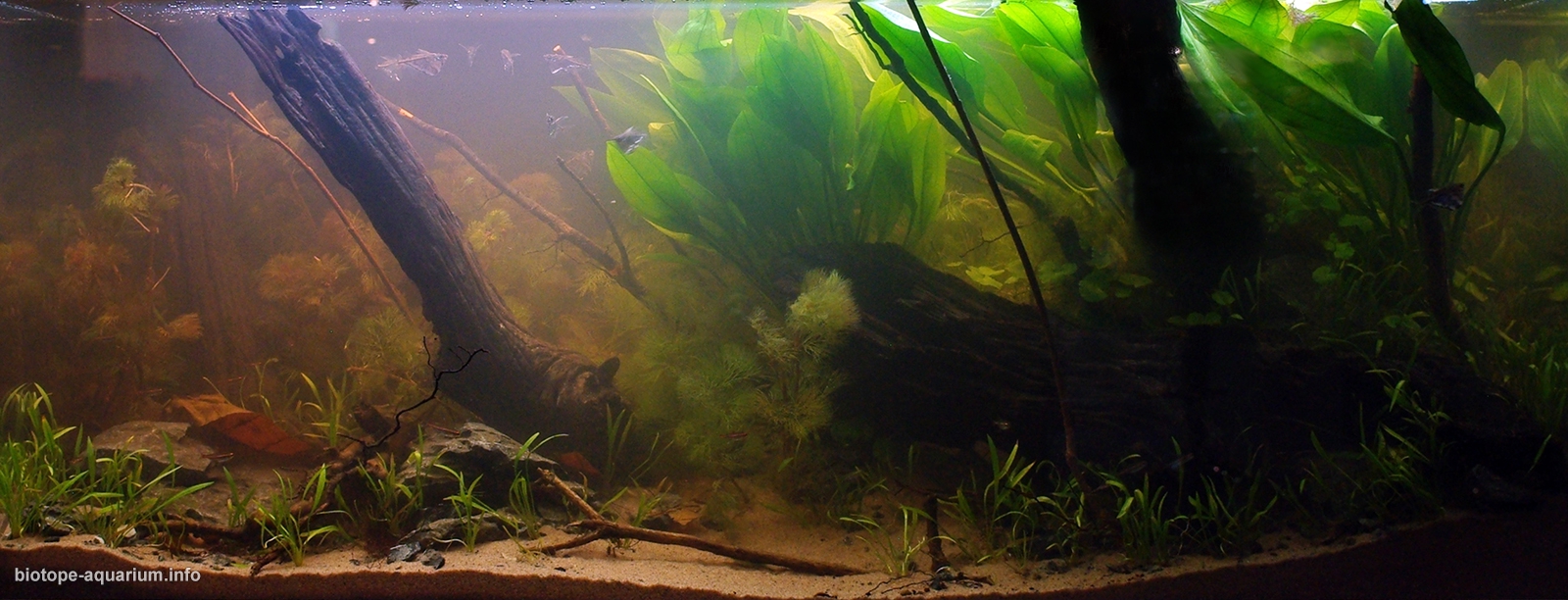Coastal area of Essequibo river, Rockstone, Guyana, 180 L
The 3rd place in the final of the Biotope Aquarium Design Contest 2013
![]() Russia. Evgenia Moiseyeva
Russia. Evgenia Moiseyeva

Volume: 180 L
List of fishes: Hemigrammus erythrozonus, Carnegiella strigata, Сorydoras aeneus.
List of plants: Cabomba furcata, Cabomba aquatica, Helanthium tenellum, Echinodorus grisebachii Bleherae.
Biotope description: Essequibo River starts in the mountains of Brazil, flows north for 1,000 km through forest and savanna and empties into the Atlantic Ocean. It has many rapids, waterfalls and islands. Rockstone is a village on the right bank of Essequibo River, known for its fishing festivals. Guyana freshwater fish fauna is extremely rich in species found nowhere else in the world, including the endemic Glowlight Tetra (Hemigrammus erythrozonus). Because of the strong flows, depth and abundance of silt, there are not many aquatic plants there, they can be found only along the banks, in the creeks and in the shallows. The bottom is covered with fine beige and red sand because of the iron.
Evgenia’s comment about the contest: It was a very difficult contest, but surprisingly interesting and exciting! When collecting materials for the selected biotope I faced a problem where to get them, because there is very little information in books and on the pages of the Internet: small articles, researches, people’s stories about their own experiences, photos. But the collecting of information turned out to be strongly addictive! I wanted to learn more and more about places and to try taking all this beauty under the water in an aquarium to create comfortable living conditions for fishes in it, and to show how beautiful such an aquarium can be, not worse than aquascape. I would like to thank contest organizers for their willingness to promote this trend. Every year the number of entries grows, the contest becomes more widespread, goes abroad. This is great! Thanks to judges! This year I noticed how difficult it was to evaluate the entries, and it says only that the level of the contest goes higher and higher. Special thanks to everyone for orgaizing the final during the exhibition, providing a great material for set up, plants of high quality and beautiful fishes! I also would like to thank the guests for their support during the exhibition, for their genuine interest in setting up biotope aquariums, for their assistance. And good luck to the future participants in this exciting and challenging contest, in creating beautiful biotope aquariums without mistakes. Spend time gathering information! Try to set up an aquarium using aquascaping techniques to create perspective, do not forget about simple rules of composition. The aquarium should look well-groomed and aesthetical, to feel your love for each branch, leaf, detail! In this case your work and effort will be highly evaluated by the members of the jury and the audience.

Very well done, compliments, only note: Hemigrammus erythrozonus is not ‘endemic’ in the Essequibo basin (also found in the Orinoco basin), and E. bleherae is not found there, only E. heikobleheri, and also not Cabomba furcata.

Pretty cloudy water makes look carefully what’s going on in a small underwater world. It turns out the school of Corydoras having fun there, tetras hiding somewhere in the thickets of Cabomba, and in the upper part at the surface of the water the school of Carnegiella. I think that the entry would look more interesting if the dry land was provided. In this case, Carnegiella would be better visible to the audience. And we must not forget that these fishes jump very well, free space above the water would not be excessive. On the photo of the informational sheet, bank and riverbed should be more rocky than in the aquarium, the coastline is formed not clearly. The cloudy water spoils the impressioan a little. The contestants should pay more attention to the filtering.

The composition of fishes is correct, that’s ok. I can not argue about the plants, but I believe that everything is also correct. Too misty water significantly spoils the overall impression, but there’s no author’s fault. Although, to clarify the water as soon as possible is also an art. In my first biotope contest padding polyester helped me very much, a large amount of it in external filter during the night fully filtered water and made it transparent. In this entry I was faced with the difficulty of defining the coastal zone. I do not really understand where it begins and ends. Whether the coastal zone is in the right corner, or it is located frontally, along the back. That’s why I as a judge had problems with the definition of correct planting. But the entry is very good, correct and strong. It would be good to take another look at this aquarium, after the water had become transparent. Alas, this is already history…
